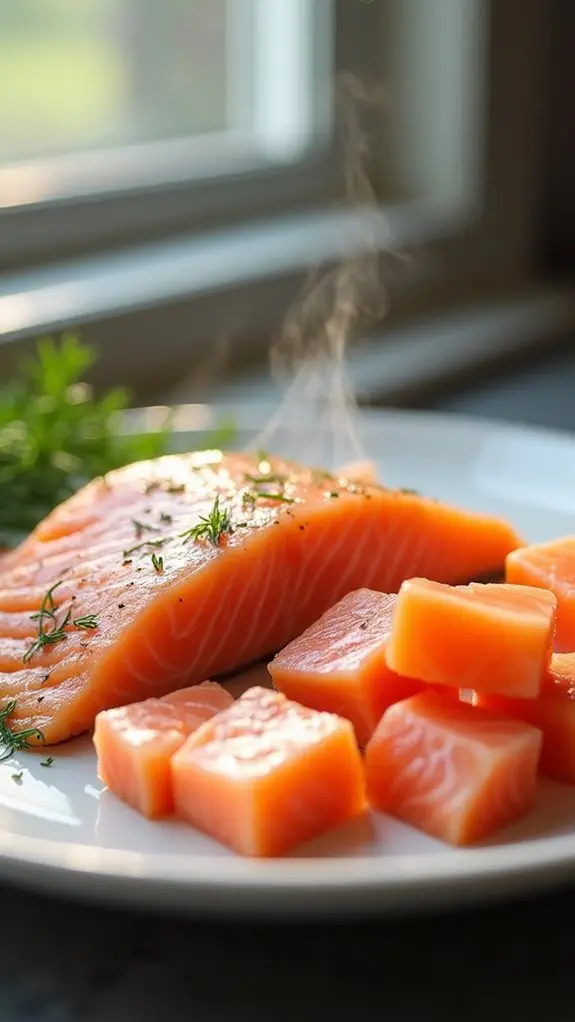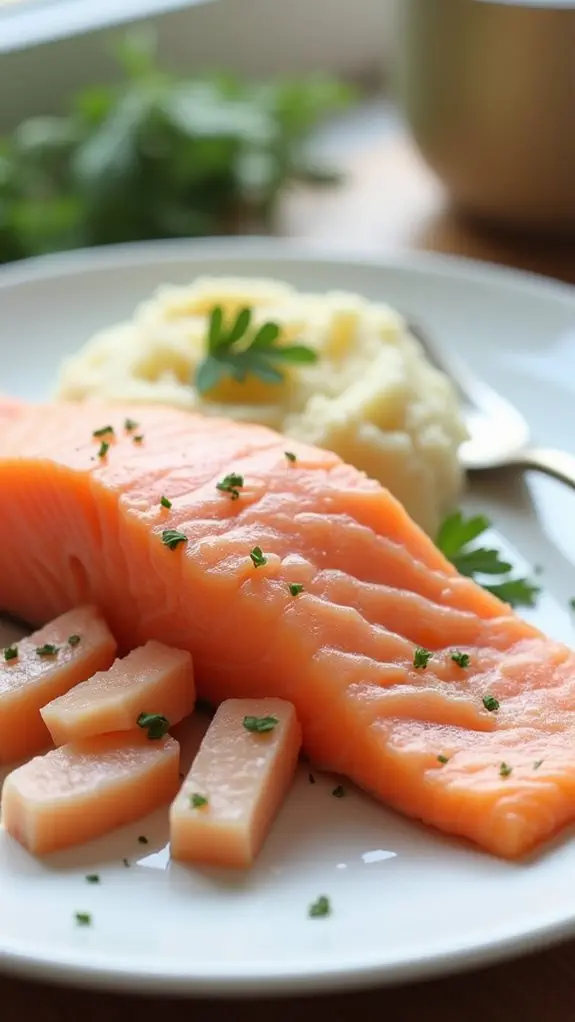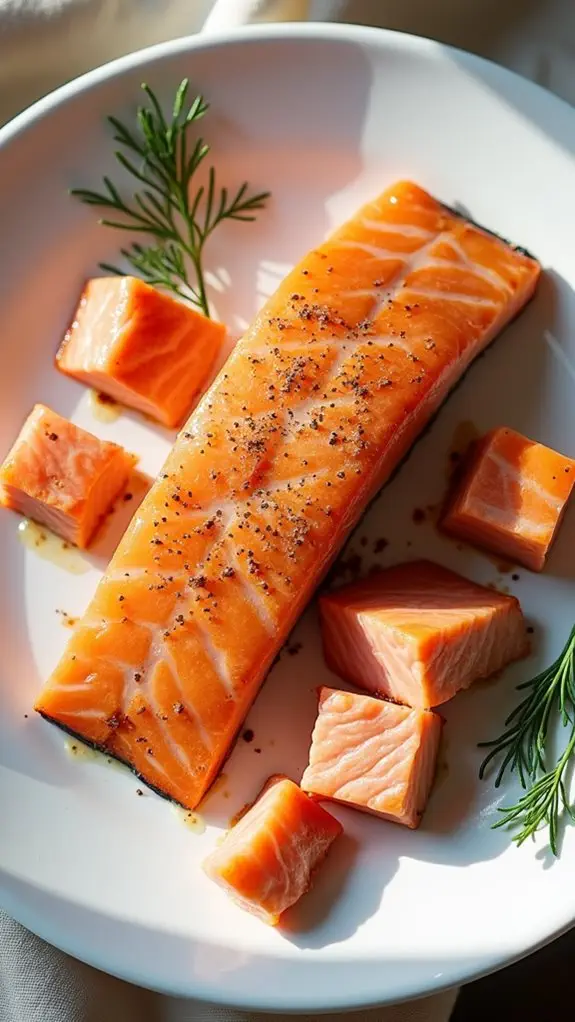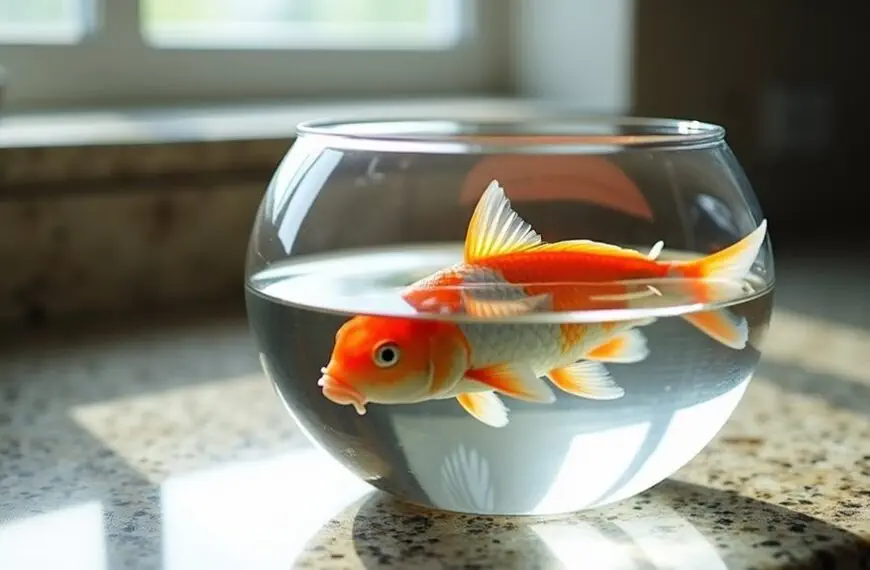Salmon is your best first fish choice for your baby, thanks to its rich omega-3 content and brain-boosting nutrients. You'll want to start around 6 months of age, serving wild-caught salmon that's been thoroughly cooked to 145°F and carefully checked for bones. Keep portions small – about the size of your thumb – and try steaming or baking for the safest preparation. Watch for any signs of allergic reactions within two hours of feeding, though fish allergies are relatively rare. Better yet, early introduction might actually help prevent allergies. There's so much more to discover about introducing fish to your little one's diet.
Contents
Why Fish Matters for Babies

From the earliest stages of development, fish plays an essential role in your baby's growth and health. When you're looking at fish nutrition for your little one, you'll find it's packed with incredible nutrients that support everything from brain development to eye health. Those omega-3 fatty acids, especially DHA and EPA, are working overtime to help your baby's nerve tissue grow strong and healthy. Fish provides important fat-soluble vitamins that aid in healthy development. Babies need 10-12 mg DHA per kg of body weight for optimal development.
You'll love knowing that fish isn't just about brain power – it's a developmental powerhouse! It's helping your baby build a robust immune system while reducing their risk of conditions like asthma and eczema. The protein and essential minerals are busy strengthening their growing bones, while choline supports healthy spinal cord development.
Plus, when you introduce fish early, you're not just feeding their body – you're expanding their palate and helping them embrace new flavors and textures. Think of fish as nature's multivitamin for your baby.
From supporting cognitive development to maintaining heart health, it's delivering an impressive array of developmental benefits that'll help your little one thrive. Just remember to choose low-mercury options, and you're setting them up for success!
Top Fish Choices for Infants
Now that you understand why fish benefits your baby's development, let's explore the best fish options for your little one. When it comes to top fish choices, you'll want to focus on varieties that are both safe and packed with nutrient benefits. The healthy fats found in fish support your baby's heart health and provide natural anti-inflammatory benefits.
Salmon, sardines, and arctic char lead the pack as excellent first fish options for your baby, thanks to their ultra-low mercury levels and impressive nutritional profiles. Early exposure around 6 months can help reduce the risk of developing fish allergies.
Here are the safest fish to start with, ranked by their overall benefits:
- Salmon – It's rich in omega-3s and vitamin D, making it perfect for supporting brain development and bone health.
- Sardines – These tiny fish pack a powerful punch with calcium from their soft bones, plus they're sustainable.
- Arctic Char – A mild-tasting fish that's similar to salmon but often more affordable.
You'll find these options readily available in most grocery stores, and they're versatile enough to prepare in various ways.
Remember to serve about 1-2 ounces per portion, and don't worry if your little one makes funny faces at first – it's all part of the adventure of trying new foods!
Safe Fish Preparation Methods

Preparing fish safely for your baby requires careful attention to both cooking methods and food handling practices. When it comes to fish cooking, you'll want to verify it reaches an internal temperature of 145°F (62.8°C) using a reliable meat thermometer – no guesswork allowed when it comes to your little one's safety!
For the best results, try gentle cooking methods like steaming, poaching, or baking. Steam salmon for about 5-6 minutes, or until it's cooked through and flakes easily. Before you start cooking, let the fish come to room temperature, and don't forget to remove any pesky bones and skin – your baby doesn't need those surprise ingredients! Consider serving wild-caught salmon as it contains higher omega-3 levels than farmed varieties. Haddock is also an excellent choice for babies, as it contains low mercury levels compared to other white fish.
When it comes to fish safety, size matters. Cut the cooked fish into pieces about the size of two adult pinky fingers placed side by side. You can get creative by mixing flaked fish with mashed avocado or plain yogurt for easier eating.
If you're following baby-led weaning, try cutting the fish into finger-shaped strips or incorporating it into homemade fish cakes. Just remember to skip the salt, sugary sauces, and honey – your baby's developing taste buds don't need these additions yet.
Recognizing Food Allergy Signs
While introducing fish to your baby is exciting, being alert to potential allergic reactions is essential.
Most people who develop fish allergies have them for their entire lives, making early detection crucial.
You'll want to watch your little one closely during and after their first few fish meals, as food allergy signs typically show up within minutes to two hours after eating. Keep your phone handy and don't hesitate to call your pediatrician if you notice anything concerning.
Many infants develop tolerance to early food allergies, with studies showing 50% outgrow them by age 5.
Here are the key symptoms to watch for:
- Mild signs: Look for hives, itchy mouth, mild rashes, or your baby seeming fussy with their tummy.
- Moderate signs: Watch for vomiting, diarrhea, or more widespread rashes.
- Severe signs: Call emergency services immediately if you notice difficulty breathing, severe coughing, or swelling of the face or throat.
It's smart to start with a small portion of fish and wait a few days before offering it again. This makes it easier to identify any reactions.
If you spot any concerning symptoms, don't panic – but do take action. Having a clear allergy management plan in place will help you feel more confident.
Weekly Fish Serving Guidelines

Once you're confident about monitoring for allergic reactions, understanding proper fish servings becomes your next focus.
You'll want to start with offering your little one 2-3 ounces of fish weekly, divided into 1-2 servings. Think of each serving as roughly the size of your thumb – that's about 1-2 ounces per meal. These servings provide essential omega-3 fatty acids that support healthy brain and eye development.
When it comes to mercury levels, you'll want to be extra careful about which fish you choose. Your safest bets are salmon, sardines, and Arctic char – these fish are like the straight-A students of the seafood world! You can serve these twice a week without worry.
If you're looking for more variety, tilapia and shrimp are also great options.
Some fish need a bit more caution – think of them as "occasional treats." Serve fish like rainbow trout and black sea bass just once every couple of weeks.
And here's what you'll definitely want to skip: shark, swordfish, and bigeye tuna are absolutely off the menu for babies due to their high mercury content.
Frequently Asked Questions
Can Babies Eat Raw Fish in Homemade Sushi Rolls?
You shouldn't feed your baby raw fish in homemade sushi rolls due to safety concerns. Instead, try sushi alternatives with cooked fish or vegetables until they're at least 2½ years old.
Should Fish Oil Supplements Replace Fish Meals for Babies?
You shouldn't replace fish meals with supplements for your baby. While fish oil benefits brain development, whole fish provides additional nutrients like protein and iron that supplements can't match. Only use supplements if fish isn't possible.
Does Cooking Fish in Milk Affect Its Nutritional Benefits?
You won't lose significant nutrients when cooking fish in milk, as there's no proven impact on nutrient retention. While milk interactions with fish are debated in traditional medicine, scientific evidence doesn't show any negative nutritional effects.
Can Babies Eat Fish Skin if It's Properly Cooked?
You shouldn't feed your baby fish skin, even if it's properly cooked. While cooking methods can make it safer, fish skin remains a choking hazard. It's best to remove it before serving.
Should Fish Be Introduced Before or After Other Protein Sources?
You can introduce fish alongside other protein sources, as current dietary guidelines don't specify strict protein timing. It's safe to start fish around 6 months, and early introduction may help prevent allergies.
Final Thoughts
Now that you're ready to introduce fish to your baby's diet, you'll find it's not as intimidating as it might seem. Start with mild, low-mercury options like salmon or cod, and always follow proper preparation guidelines. Remember to watch for any signs of allergies, and don't forget to make mealtime fun! With these fish-feeding basics under your belt, you're well-equipped to give your little one a healthy, delicious start to seafood.












